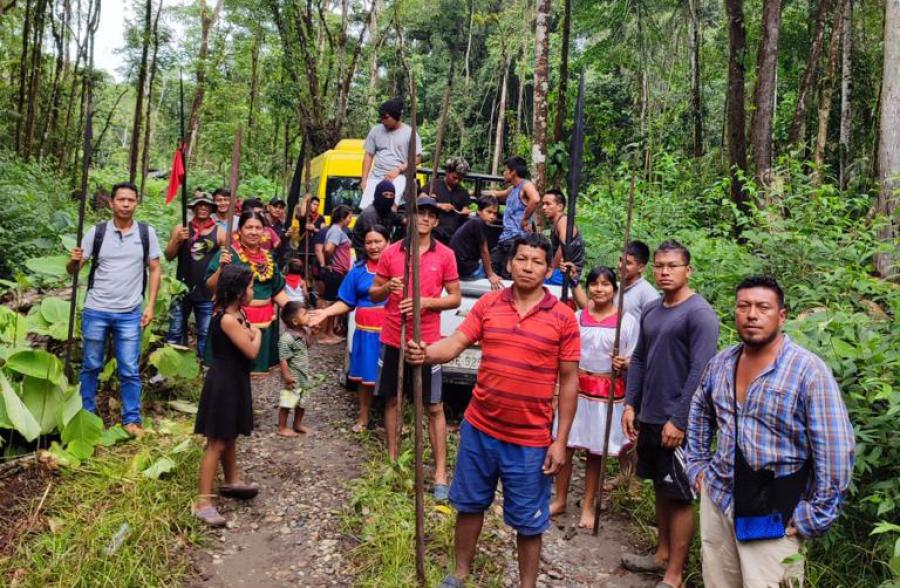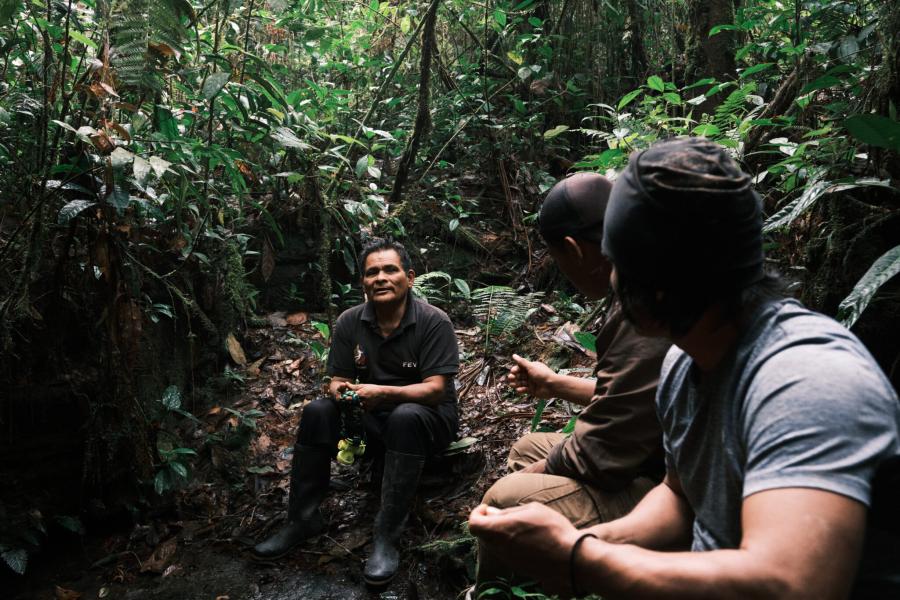The territory of the Achuar, the people of the swamp palm, is a vast and remote territory straddling the long-disputed border of Peru and Ecuador, spanning nearly three million acres of forest.
There are approximately 65 Achuar communities, made up of 50 to 500 people and scattered over a wide area of forest. Among the Achuar, hunting is primarily a male activity, while women are responsible for the communities’ gardens. The typical Achuar garden contains many kinds of plants, but the centerpiece of the garden and the staple of their diet is the manioc plant. The dynamic and complex relationship between this plant and its female cultivator is profound.
The garden, or chakra, is the domain of the woman only, and gardening is a fundamentally spiritual activity. The spirit being who created cultivated plants and controls the garden is Nunkui. An Achuar gardener has to develop a relationship with Nunkui as well as with the plants in the garden if she hopes to be successful. To do that, she will sing anents, or magical prayers to the plants, referring to them as her children. These birdlike melodies are intensely personal and deeply spiritual, often sung in private, under the breath, or even silently in her head, as they are not to be heard by anyone but Nunkui. If a women is lucky, Nunkui will appear to her in a dream, revealing to her where to find a special stone, which, when buried in her garden, will enrich the soil, causing her garden to flourish.
The spiritual importance of the garden is not limited to plants: Achuar women typically give birth in their gardens. But the garden is not a refuge. On the contrary, it’s seen as a hostile place. According to Achuar belief, when Nunkui first gave cultivated plants to an Achuar family, she was angered by the way the family mistreated her “children,” and she cursed the people so that plants would only grow if the people went to extraordinary lengths to care for them. The manioc plant on which they depend is especially hostile. The Achuar believe that the manioc plant is vampiristic, that the leaves of the plant will suck the blood out of anyone who brushes against them. They consider the blood in a body to be finite and irreplaceable, so any loss is a major concern. The anents a woman sings in her garden are intended to placate the manioc plants and keep the woman and her daughters safe in the garden. For the Achuar, anemia in a child is a sure signal to a mother that her manioc plants are not receiving enough attention and prayer.
A typical Achuar woman’s garden is made up of plantain, banana, sweet potato, chonta palm, guava, cocoa, papaya, peanuts, melons, caimito (star apple), sweetsop, and avocado. But, of all the abundance in an Achuar garden, the manioc plant is the most prized and depended upon. Therefore, every Achuar woman and girl strives for robust and shiny plants. Every nine months, the Achuar harvest the plant by disinterring long tuberoid roots, which are always replaced by a cutting from the mother plant to grow again. In this way, the supply of manioc root is never depleted.
Chicha is a fermented alcoholic beverage found throughout Latin America and variously made from plants like corn, sugarcane, or pineapple, but the Achuar’s chicha, or nijiamanch, is made from manioc root. This yeasty brew is central to the Achuar diet, often substituting for food and water. From the women’s very complex relationship in cultivating the manioc plant to the long hours spent harvesting clay and decorating the ceramic pots from which the brew is drunk, the role of chicha is entirely fundamental to Achuar identity.
When chicha is not fermenting in large clay pots on hard dirt floors, it is being cultivated, sung or whispered to, harvested, or doled out in both homes and communal gatherings. Some men drink as many as six bowlfuls in one sitting, or as much as three gallons a day, often skipping meals. In the not-so-distant times of tribal warfare, men would bring only chicha with them for refreshment, foraging and hunting along the way. Though men depend on chicha, the gender issues of cultivation mean that they will neither enter a manioc garden nor come in direct physical contact with the plant itself. In fact, should an insect fall into a man’s bowl of chicha, he will wait for his female server to extract the animal, leaving his lips as the only part of his body that meets the drink.
The process of chicha-making is a crucial skill, passed down from a mother to her daughter when the daughter is around 10 years old. A woman first peels, hacks, and boils the manioc in a large pot, then chews it arduously, with her saliva providing the fermenting agent. With cheeks stuffed, she chews until the root has been turned into a fine liquid, which she then skillfully strains through her teeth and spits back into her personal chicha pot. She then uses a paddle to mash the liquid into a smooth paste and leaves the result to ferment under a cover of plantain leaves. Just as each woman has her own chicha pot, so does each woman give her chicha a distinct and personal touch. Taste and texture contrasts vastly from woman to woman. Some women will become admired and sought after for their chicha, while others’ brews may seem far too fibrous or sour.
When serving, the women knead the pulp, lifting out the fibers before mixing the paste with water and pouring the creamy liquid into clay bowls, called pinin. Alcohol levels vary depending on the time of the day it is served; sweet chicha is typically consumed in the morning while the more vinegary and intoxicating chicha is reserved for guests, parties, or special gatherings.
When a guest arrives in a Achuar home, the woman of the house immediately offers a large bowl of chicha, and if a man has multiple wives, each wife will offer her own brew in her own bowl. A guest who declines a bowl of chicha gives a serious insult to the woman serving, implying that he distrusts the host. But no Achuar guest would ever make that mistake, knowing the spiritual connections of this most important drink.
Stephanie Hartka is a writer and photographer living and traveling between Latin America and Hudson, New York. Stephanie recently spent six months living with the Achuar people as a co-founder of Wachirpas Volunteer Program.



